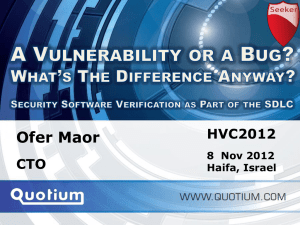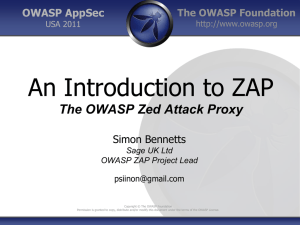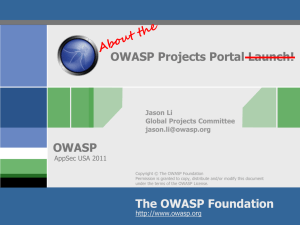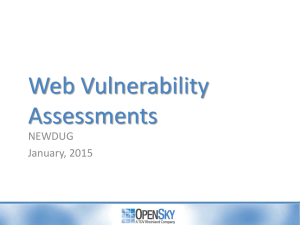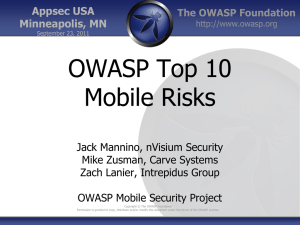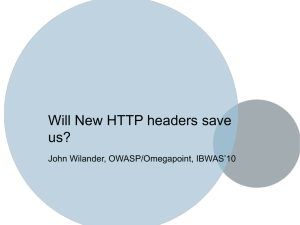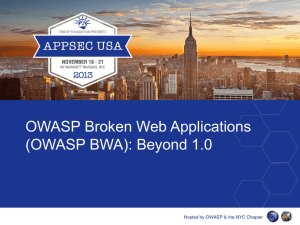WCF Security Talk - OWASP Los Angeles
advertisement
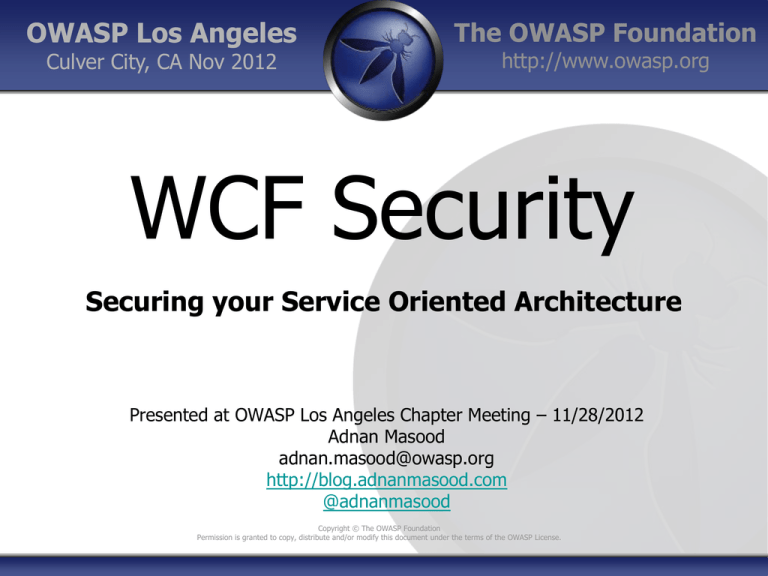
OWASP Los Angeles Culver City, CA Nov 2012 The OWASP Foundation http://www.owasp.org WCF Security Securing your Service Oriented Architecture Presented at OWASP Los Angeles Chapter Meeting – 11/28/2012 Adnan Masood adnan.masood@owasp.org http://blog.adnanmasood.com @adnanmasood Copyright © The OWASP Foundation Permission is granted to copy, distribute and/or modify this document under the terms of the OWASP License. The OWASP Foundation http://www.owasp.org about the speaker Adnan Masood works as a system architect / technical lead for Green dot Corporation where he develops SOA based middle-tier architectures, distributed systems, and web-applications using Microsoft technologies. He is a Microsoft Certified Trainer holding several technical certifications, including MCPD (Enterprise Developer), MCSD .NET, and SCJP-II. Adnan is attributed and published in print media and on the Web; he also teaches Windows Communication Foundation (WCF) courses at the University of California at San Diego and regularly presents at local code camps and user groups. He is actively involved in the .NET community as cofounder and president of the of San Gabriel Valley .NET Developers group. Adnan holds a Master’s degree in Computer Science; he is currently a doctoral student working towards PhD in Machine Learning; specifically discovering interestingness measures in outliers using Bayesian Belief Networks. He also holds systems architecture certification from MIT and SOA Smarts certification from Carnegie Melon University. Copyright © The OWASP Foundation Permission is granted to copy, distribute and/or modify this document under the terms of the OWASP License. The OWASP Foundation http://www.owasp.org Service Oriented Architecture A service-oriented architecture (SOA) is a set of principles and methodologies for designing and developing software in the form of interoperable services. Copyright © The OWASP Foundation Permission is granted to copy, distribute and/or modify this document under the terms of the OWASP License. The OWASP Foundation http://www.owasp.org Copyright © The OWASP Foundation Permission is granted to copy, distribute and/or modify this document under the terms of the OWASP License. The OWASP Foundation http://www.owasp.org What is an SOA Service? A SOA service is composed of three parts: A service class that implements the service to be provided A host environment to host the service One or more endpoints to which clients will connect All communication with a service happens through the endpoints. Each endpoint specifies a contract (which we will discuss in greater detail later in this chapter) that defines which methods of the service class will be accessible to the client through that specific endpoint. Because the endpoints have their own contracts, they may expose different (and perhaps overlapping) sets of methods. Each endpoint also defines a binding that specifies how a client will communicate with the service and the address where the endpoint is hosted. Copyright © The OWASP Foundation Permission is granted to copy, distribute and/or modify this document under the terms of the OWASP License. The OWASP Foundation http://www.owasp.org Tenants of SOA Boundaries are explicit. Services are autonomous. Schemas and contracts are shared, but not classes. Compatibility is based on policy. Copyright © The OWASP Foundation Permission is granted to copy, distribute and/or modify this document under the terms of the OWASP License. The OWASP Foundation http://www.owasp.org Web Services Protocol Stack Copyright © The OWASP Foundation Permission is granted to copy, distribute and/or modify this document under the terms of the OWASP License. http://msdn.microsoft.com/en-us/library/orm-9780596527563-01-10.aspx The OWASP Foundation http://www.owasp.org SOA using WCF Interoperability across platforms Unification of existing technologies Enabling service-oriented development Copyright © The OWASP Foundation Permission is granted to copy, distribute and/or modify this document under the terms of the OWASP License. The OWASP Foundation http://www.owasp.org Copyright © The OWASP Foundation Permission is granted to copy, distribute and/or modify this document under the terms of the OWASP License. The OWASP Foundation http://www.owasp.org What is WCF? Microsoft .Net framework API that unifies many existing standards: WS-Addressing, WSReliableMessaging, WS-Security etc. Supports a number of different protocols Compatible with non-Microsoft web services and clients Service Oriented Architecture A WCF Service is composed of Service class, hosting environment and one or more Endpoints Copyright © The OWASP Foundation Permission is granted to copy, distribute and/or modify this document under the terms of the OWASP License. The OWASP Foundation http://www.owasp.org Endpoint = ABC Address (where is service) http://localhost:8000/servicename Binding (how do I talk to it) WSHttpBinding Contract (what can it do) [ServiceContract] [DataContract] [OperationContract] [FaultContract] Copyright © The OWASP Foundation Permission is granted to copy, distribute and/or modify this document under the terms of the OWASP License. The OWASP Foundation http://www.owasp.org WCF Authentication (who) Who are you (client, server)? Authentication Types: None, Windows authentication, Username and Password, X.509 Certificate, Issued Token, Custom For Certificate, the local Cert Store is checked. IIdentity interface. Copyright © The OWASP Foundation Permission is granted to copy, distribute and/or modify this document under the terms of the OWASP License. The OWASP Foundation http://www.owasp.org WCF Authorization (what) What does the client have access to do? Windows Groups (default) ASP.Net Membership provider (SQL Server) WCF provides IPrincipal interface and some implementing classes. Copyright © The OWASP Foundation Permission is granted to copy, distribute and/or modify this document under the terms of the OWASP License. The OWASP Foundation http://www.owasp.org WCF Transfer Security (how) How are messages secured while in transit? Transfer Security types: None, Transport, Message, Mixed, Both Message: end to end, slower, more complicated Transport: fast, hop-to-hop Copyright © The OWASP Foundation Permission is granted to copy, distribute and/or modify this document under the terms of the OWASP License. The OWASP Foundation http://www.owasp.org WCF provides three important security features Confidentiality Integrity Authentication Security is on by default in almost all bindings You configure transport vs. Message using the security mode You configure Authentication via the client credential type WCF Provides numerous authorization options Impersonation Role based access control Service authorization behavior Copyright © The OWASP Foundation Permission is granted to copy, distribute and/or modify this document under the terms of the OWASP License. The OWASP Foundation http://www.owasp.org The CIA of Security Is Security Important? Do you have resources that have value to an adversary? If yes, then you must expect to be attacked. WCF provides basic protections that you need: CIA. Confidentiality Integrity Authentication Encrypting Messages Mitigates eavesdropping attacks. Signing messages mitigates tampering and replay attacks. Proof of identity mitigates spoofing and impersonation attacks. Copyright © The OWASP Foundation Permission is granted to copy, distribute and/or modify this document under the terms of the OWASP License. The OWASP Foundation http://www.owasp.org Decisions Decisions! The protection level required by your services Should the data be signed, encrypted or both? Transport vs. message security on bindings Can also use a hybrid of the two Authentication, or “who are you?” You choose the type of credentials you want the client to use and WCF will pick an appropriate authentication protocol Authorization or “what are you allowed to do?” Impersonate the caller, letting someone else handle authz Provide your own authorization management Copyright © The OWASP Foundation Permission is granted to copy, distribute and/or modify this document under the terms of the OWASP License. The OWASP Foundation http://www.owasp.org Declaring the required protection level The developer of a service doesn’t ultimately control how it’s exposed So what if the host application exposes unsecure endpoints Hence, developers can set the required protection level on contracts The host will fail if the required protection level isn’t met by an endpoint Setting Protection Level at Different Scopes On a particular message On individual operations and fault contracts On a service contract Copyright © The OWASP Foundation Permission is granted to copy, distribute and/or modify this document under the terms of the OWASP License. The OWASP Foundation http://www.owasp.org Protection Level Simply use the protection level property on the appropriate attribute Possible Values: None, Sign, and EncryptAndSign Copyright © The OWASP Foundation Permission is granted to copy, distribute and/or modify this document under the terms of the OWASP License. The OWASP Foundation http://www.owasp.org Configuring security in WCF Bindings Security Mode Client Credential Type Transport Message Mixed Username Certificate Windows IssuedToken These two choices determine how security protocols will be implemented. Copyright © The OWASP Foundation Permission is granted to copy, distribute and/or modify this document under the terms of the OWASP License. The OWASP Foundation http://www.owasp.org Bindings Configuration Windows Integrated Authentication <wsHttpBinding> <binding name="MyTransportSecurityBinding"> <security mode="Transport"> <transport clientCredentialType="Windows"/> </security> </binding> </wsHttpBinding> Service Supplies X.509 cert; client supplies username + password <wsHttpBinding> <binding name="MyMessageSecurityBinding"> <security mode="Message"> <message clientCredentialType="UserName"/> </security> </binding> </wsHttpBinding> Service runs SSL client supplies SAML token <wsHttpBinding> <binding name="MyMixedSecurityBinding"> <security mode="TransportWithMessageCredential"> <message clientCredentialType="IssuedToken"/> </security> </binding> </wsHttpBinding> Copyright © The OWASP Foundation Configuring Binding Security Settings Permission is granted to copy, distribute and/or modify this document under the terms of the OWASP License. The OWASP Foundation http://www.owasp.org Transport Security Each Transport typically has a built in security layer that you can use HTTP using SSL TCP/NP using Kerberos MSMQ using certificates Provides point to point security between nodes Copyright © The OWASP Foundation Permission is granted to copy, distribute and/or modify this document under the terms of the OWASP License. The OWASP Foundation http://www.owasp.org Transport Security Trade-Offs Benefits Mature and well understood Security Model Better Performance Drawbacks Constrains the type of client credentials You get point to point authentication, not end to end authentication Copyright © The OWASP Foundation Permission is granted to copy, distribute and/or modify this document under the terms of the OWASP License. The OWASP Foundation http://www.owasp.org Message Security Message Security pushes authentication down into SOAP headers Provides same security features as transport security But in transport-neutral way (pushes security into SOAP messages) Provides an end to end security solution across all nodes Copyright © The OWASP Foundation Permission is granted to copy, distribute and/or modify this document under the terms of the OWASP License. The OWASP Foundation http://www.owasp.org Interesting Analogy http://blogs.msdn.com/b/vbertocci/archive/2005/04/25/end-to-endsecurity-or-why-you-shouldn-t-drive-your-motorcycle-naked.aspx Copyright © The OWASP Foundation Permission is granted to copy, distribute and/or modify this document under the terms of the OWASP License. The OWASP Foundation http://www.owasp.org Message Security Tradeoffs Benefits Supports a wide variety of crednentials Largely independent of transport Supports end to end authentication Multiple WCF extensibility hooks Drawbacks Newer isn’t always better for security WS-* isn’t as broadly adopted as SSL Perf can be significantly worse Copyright © The OWASP Foundation Permission is granted to copy, distribute and/or modify this document under the terms of the OWASP License. The OWASP Foundation http://www.owasp.org Mixed Mode TransportwithMessageCredential Speed and maturity of transport security Flexibility of client credentail types embdeed in message Transport security typically supplied by SSL Authenticates service to client via service’s certificate Sign and encrypt payload WS-Security header holds client credential Opens Up many options for credential format Copyright © The OWASP Foundation Permission is granted to copy, distribute and/or modify this document under the terms of the OWASP License. The OWASP Foundation http://www.owasp.org Authentication in standard bindings Binding Name Transport Message Default Client Credential BasicHttpBinding Supported Supported None WSHttpBinding Supported Default Windows WSDualHttpBinding Supported Default Windows NetTcpBinding Default Supported Windows NetNamedPipesBinding Default Supported NetMsmqBinding Default Supported Copyright © The OWASP Foundation Permission is granted to copy, distribute and/or modify this document under the terms of the OWASP License. The OWASP Foundation http://www.owasp.org Security Call Context Every secure WCF operation has a ServiceSecurityContext object ServiceSecurityContext.Current OperationContext.ServiceSecurityContext The context object provides you with information about the caller Use PrimaryIdentity or WindowsIdentity to access the IIdentity object IsAnonymous will tell you if it was an anonymous call Copyright © The OWASP Foundation Permission is granted to copy, distribute and/or modify this document under the terms of the OWASP License. The OWASP Foundation http://www.owasp.org Authorization Options Role-based Access Control Windows groups a simple option (use Iprincipal) Use an ASP.NET role provider PrincipalPermission works reasonably well ServiceAuthorizationBehavior Decision based on SOAP action & client identity Fires earlier than PrincipalPermission Keeps Authz logic out of service implementation Impersonation Only an option with windows crednetials User WindowsIdentity.Impersonate or [OperationBehavior] Copyright © The OWASP Foundation Permission is granted to copy, distribute and/or modify this document under the terms of the OWASP License. The OWASP Foundation http://www.owasp.org Impersonation Impersonation is a Windows Feature Must be using Windows authentication for this to work Easy to get this working for local resources Trickier for remote resources (requires delegation) Temporarily take on the client identity You’re passing the authorization problem to a system behind you Great when you’re accessing existing secure resources Can eliminate the need for you to implement authz in your app Copyright © The OWASP Foundation Permission is granted to copy, distribute and/or modify this document under the terms of the OWASP License. Summary & Conclusion The OWASP Foundation http://www.owasp.org WCF provides three important security features Confidentiality Integrity Authentication Security is on by default in almost all bindings You configure transport vs. message using the security mode You configure authentication via the client credential type WCF provides numerous authorization options Impersonation Role-based access control via groups, roles or claims Service authorization behavior Copyright © The OWASP Foundation Permission is granted to copy, distribute and/or modify this document under the terms of the OWASP License. The OWASP Foundation http://www.owasp.org References Security in Windows Communication Foundation http://msdn.microsoft.com/en-us/magazine/cc163570.aspx WCF Security Architecture http://msdn.microsoft.com/en-us/library/ms788756.aspx Pluralsight course on WCF Security http://pluralsight.com/training/courses/TableOfContents?courseName=wc f-design-concepts&highlight=aaron-skonnard_security#security Fundamentals of WCF Security www.code-magazine.com/article.aspx?quickid=0611051 6 Steps to Implement DUAL Security on WCF using User name + SSL http://www.codeproject.com/Articles/82737/6-Steps-to-Implement-DUALSecurity-on-WCF-using-Us Copyright © The OWASP Foundation Permission is granted to copy, distribute and/or modify this document under the terms of the OWASP License. The OWASP Foundation http://www.owasp.org Thank You! Adnan Masood adnan.masood@owasp.org @adnanmasood Blog: www.AdnanMasood.com Pasadena .NET User Group: www.sgvdotnet.org Copyright © The OWASP Foundation Permission is granted to copy, distribute and/or modify this document under the terms of the OWASP License.


